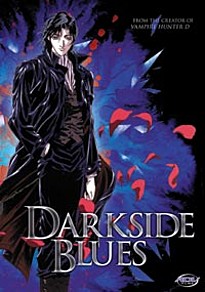Review
by Casey Brienza,Darkside Blues
DVD
| Synopsis: |  |
||
The Persona Century Corporation has taken over the world, and only the rebel group Messiah has the will to stand up against its power. Tatsuya, one of Messiah's operatives, narrowly escapes Persona capture and takes refuge in Kabuki-cho, also known as “The Dark Side of Tokyo,” the only place where Persona's uncompromising light does not yet shine. A haven for misfits and criminals, Tatsuya falls under the protection of Mai and her gang of Kabuki-cho independents. Meanwhile, a mysterious man driving a horse-drawn carriage who calls himself “Darkside” has emerged from the enfolding darkness and taken up residence in the district, and his aim appears to involve the overthrow of Persona. What will happen when Darkside, Mai, and the members—both old and new—of Messiah cross paths? Is it the end for Persona…or just the end of the beginning? |
|||
| Review: | |||
Ah, Darkside Blues…that 80 minute refugee from the good old days of violent, post-apocalyptic late twentieth century anime that make absolutely no sense because they are actually bolt-on bonuses to otherwise (we might hope, even if we have little objective reason to) more comprehensible manga series. Think, oh, Akira lite. The Darkside Blues OVA is based upon an original manga series of the same name by writer Hideyuki Kikuchi (Vampire Hunter D) and Yūho Ashibe (Bride of Deimos). It is a marriage made in heaven, with the bizarre and beautiful, grotesque and glamorous mixed together in equal measure. So on one hand, you have the Byron-esque, androgynous Darkside and, on the other, visceral, and often sexualized, violence perpetrated by the bad guys of the Persona Corporation. In fact, it is this dislocating aesthetic mix that brought an entire generation of devotees to the altar of anime fandom, and this show is, true to form, both fascinating and infuriating. In the larger scheme of things, you will, after eighty minutes of viewing time and no other background with the storyline, have little idea of what larger issues are at play. There is the mysterious and perhaps sinister child Katari and the relationship between the head of Persona and Mai, but neither of these things are resolved or even explicated—there is just enough hinted at to tantalize. Really, the only lucid storyline is, by comparison, a minor subplot involving the star-crossed—but soon doomed—relationship between Tatsuya and Selia. I will not spoil this bit of plot outright, but suffice it to say that by the end you may safely write off both characters. Which leaves us enigmatic eye candy like Darkside and gratuitous, quite creative violence at the hands of the various Persona flunkies. Which of these two types of fanservice you prefer probably depends in large part upon your otaku pedigree: If you are a fujoshi, you will adore Darkside's ambiguous sexuality and female Japanese voice actor. (There is also one throwaway line late in the show from a Persona flunkie soon to be exterminated that inspired legions of semi-starved Western yaoi fans back in the day. See if you can spot it.) If you are an old school anime fan, you will love the very adult extremes that a medium more often associated with sanitized entertainment for children can take. These two pedigrees are not necessarily mutually exclusive, of course. But in actuality, these two sides of the fandom divide are actually not so different in their tastes as it might at first seem. Both are keyed into the style and artistic craft on offer in Darkside Blues—both considerable assets. Although those used to the hyper-real perfection of computerized animation might find this vintage show sloppy or less attractive, when viewed through the lens of the pre-digital possible, it stands up quite well. There is considerable detail invested into the world of this anime, and the bright world of the Persona Century Corporation, along with the relief of the night that Darkside brings with him, is palatable. The characters are all quite nicely designed and reasonably well animated as well. If these days it all looks like one tired cliché, that just speaks to the affective power of the sort of design that series like Darkside Blues pioneered. Arguably, though, the best thing about Darkside Blues is its soundtrack. The anime takes its cues from the title and incorporates plenty of heavy-handed blues music. There is even a vocal track which does a passable rendition of bluesy Ebonics by way of slurred Japanese-accented English. The Japanese voice actors seem well chosen. Natsuki Sakan as Darkside in particular is unforgettable; she turns what might otherwise be your usual brooding bishounen into a star straight off the Takarazuka Revue stage. By comparison, the English language cast, headed by the unfortunate choice for Matthew Harrington for Darkside, are unfortunately campy by comparison. Those fans who follow North American voice actors, though, may be interested to note that the now extremely experienced Rachel Lillis makes a cameo appearance here. The ADV re-release of Darkside Blues is, to put it generously, minimalist. There are no bonus features, and the picture quality recalls the days before obligatory HD. In fact, both the English language dub and subtitles hail from the old U.S. Manga Corps/Central Park Media release, which is ironic, given what we now know about both licensers' ultimate fates. Still, it's safe to conclude that such inscrutable yet compelling cult classics as Darkside Blues will survive into the new millennium. |
| Grade: | |||
|
Overall (dub) : B
Overall (sub) : B+
Story : C+
Animation : B+
Art : A-
Music : A-
+ Vintage style and gobs of fanservice that, thus far at least, stand up to the test of time. |
|||
| discuss this in the forum (10 posts) | | |||
| Production Info: | ||
|
Full encyclopedia details about Release information about |
||